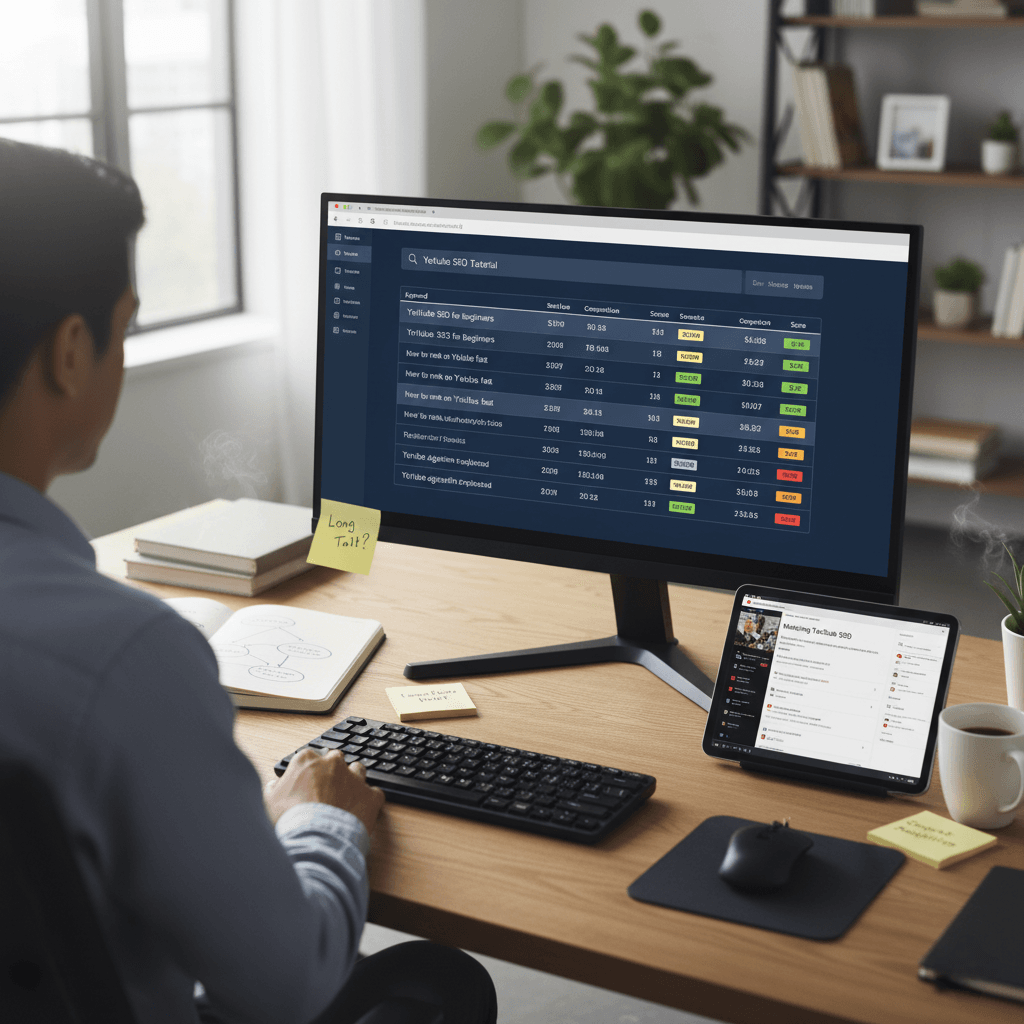Demystifying the YouTube Algorithm: How YouTube Decides What to Show You
What is the “Algorithm” Anyway?
Imagine the YouTube algorithm as a helpful librarian. This librarian’s main goal is to find the perfect book (a video) for every single person who walks into the vast library (YouTube). But the job doesn’t stop there; the librarian also wants to keep you engaged, suggesting new books that you’ll love, so you stay in the library and keep reading for as long as possible.
This guide will pull back the curtain and explain exactly how this “librarian” makes its decisions. By understanding the system, new creators and curious students can learn how to give the algorithm the right signals so it knows exactly who will love their content.
1. The Two Roads to Discovery: Search vs. Recommendations
There are two primary ways that YouTube’s algorithm shows your video to people: when they are actively looking for something, and when YouTube proactively suggests it. Understanding the difference is the first step to growing on the platform.
| Feature | YouTube Search 🔎 | YouTube Recommendations 💡 |
| Viewer Action | The viewer actively types something into the search bar. | YouTube suggests videos on the Homepage or in the “Up Next” sidebar. |
| Algorithm’s Goal | To find the most relevant video for a specific search query. | To find the most satisfying video to keep the viewer watching. |
| Creator’s Job | Tell YouTube exactly what your video is about. | Create a video that people genuinely enjoy and engage with. |
While recommendations drive the majority of views on the platform, mastering YouTube Search is a critical foundation for any new channel. Let’s explore how to win that first battle.

2. Winning with Search: Telling YouTube What Your Video is About
“Search Engine Optimization” (SEO) on YouTube is simply the process of giving the algorithm clear clues so it understands your video’s topic. This is crucial because, while YouTube’s AI is getting smarter, it can’t “watch” and understand the nuance of your video like a human can. It relies heavily on the text you provide.
2.1. The Power of Keywords
Keywords are the words or phrases that people type into the search bar. Finding the right keywords isn’t about targeting the most popular topics; it’s about discovering what your potential audience is looking for that isn’t already dominated by thousands of huge channels.
“The difference between successful YouTubers and struggling ones isn’t luck—it’s strategic keyword research. Smart creators use keyword research tools to find high-demand, low-competition opportunities they can actually rank for.”
2.2. The 3 Most Important Places to Put Your Keywords
To give the algorithm the clearest possible signals, you need to place your main keyword in three critical locations.

- In Your Video Title This is the most important ranking factor for YouTube search. Your title should include your main keyword, preferably near the beginning, to signal its relevance immediately. Aim to keep your title under 70 characters. This prevents your title from being cut off in search results, ensuring a viewer instantly understands what your video is about.
- In Your Video Description The first 1-2 sentences (about 150 characters) are the most important part of your description. Why? Because they appear directly under your video in search results, acting as a “mini-headline” that convinces a searcher to click. You should write a detailed description of at least 250 words that naturally uses your main keyword 2-4 times to give YouTube more context about your video’s topic.
- Spoken in Your Video YouTube automatically transcribes every video uploaded to the platform. This is a powerful signal because YouTube’s algorithm doesn’t just read your title and description; it ‘listens’ by analyzing the auto-generated transcript. When your spoken words match your written metadata, it confirms the video’s topic with a high degree of confidence, leaving no room for algorithmic misinterpretation.
But getting found is just the first handshake. Now you have to earn the viewer’s time and prove to the algorithm that your content delivers on its promise. That’s where recommendations come in.
3. Winning with Recommendations: Proving Your Video is High-Quality
Once YouTube has an idea of your video’s topic, it runs a test by showing it to a small group of viewers. The video’s performance in this initial test determines if it gets recommended to a much larger audience. The two most important performance metrics are Audience Retention and Click-Through Rate.
3.1. Audience Retention: The Ultimate Quality Signal
Audience Retention is the average percentage of your video that people watch. It is the single most important ranking factor on YouTube because it directly tells the algorithm whether your content is engaging and satisfying.
- Data shows that videos ranking #1 in search have an average watch time 2.8x longer than videos on the second page of results.
- The first 15-30 seconds of your video, known as the “hook,” are the most critical. If you lose a large portion of your viewers in this initial period, the algorithm takes that as a strong negative signal.
- High retention tells YouTube that your content is valuable and is successfully keeping people on the platform, which is YouTube’s ultimate goal.
3.2. Click-Through Rate (CTR): Winning the First Impression
Click-Through Rate (CTR) is the percentage of people who click to watch your video after seeing its title and thumbnail on YouTube. A high CTR tells YouTube that your video’s “packaging” is compelling and relevant to viewers.
Here are some benchmarks for what a “good” CTR looks like on different parts of the platform:
| Traffic Source | Good CTR |
| YouTube Search | 5-10% |
| Suggested Videos | 3-6% |
| Browse Features | 2-4% |
To achieve a high CTR, your video’s thumbnail is your most powerful tool. Here are the best practices for creating a “clickable” thumbnail:
- High Contrast: Use bold, contrasting colors to make your thumbnail visually pop. On a crowded homepage, a thumbnail that stands out from the competition is more likely to grab a viewer’s attention and earn the click.
- Human Element: Whenever possible, include an expressive human face. Our eyes are naturally drawn to other faces, and this element creates an immediate emotional connection that can make a viewer choose your video over a more sterile, text-based thumbnail.
- Minimal Text: Use no more than 5-7 large, easy-to-read words. Remember that your thumbnail will be seen at a small size on mobile devices, often for only a split second. The goal is instant comprehension, not detailed explanation.
While these signals are designed to identify high-quality, relevant content, the algorithm’s intense focus on maximizing engagement can sometimes have unintended side effects.
4. Algorithmic Bias: When Engagement Overrides Relevance
Because the algorithm’s primary goal is to keep people watching for as long as possible, it sometimes learns to favor popular, high-engagement videos even if they aren’t the most relevant to a viewer’s initial interest. This can lead to a phenomenon known as “content drift.”
4.1. The Case of “Content Drift”
In a recent academic study, researchers analyzed YouTube Shorts recommendations to see how the algorithm guided viewers.
- They began their experiment by watching Shorts about a serious geopolitical topic: the “South China Sea Dispute.”
- They found that after just a few recommended videos (a “depth” of 5), the algorithm had already “drifted” to suggesting videos on completely unrelated, entertainment-focused topics like crafting, gaming, memes, and dance.
- The study’s conclusion highlights how quickly the algorithm’s priorities can shift away from a user’s initial topic of interest.
“Our findings reveal a significant drift in recommended content from serious geopolitical topics to broader, entertainment-focused themes, underscoring the impact of algorithmic preferences on user engagement.”
4.2. Why Does This Happen? Popularity Bias
This “drift” occurs because the algorithm has a built-in “popularity bias.” The research found that the recommended entertainment videos had dramatically higher engagement metrics (more views, likes, and comments) than the initial, more serious videos about the geopolitical dispute.
The algorithm learns that broadly popular and entertaining content is a safer bet for keeping the average user engaged than niche or serious topics. While this is effective for maximizing overall watch time on the platform, it can sometimes lead to the unintentional neglect of important or specialized subjects in favor of what is universally popular.
Understanding these mechanics allows creators to build a clear and actionable strategy for working with the algorithm, not against it.
5. Your Roadmap to Working with the Algorithm
The YouTube algorithm isn’t a mysterious force to be feared, but a system that responds to clear signals from creators. By understanding what it’s looking for—clarity, quality, and viewer satisfaction—you can create content that the system is designed to promote.
We also recommend reading about Amazon keyword research and Etsy keyword research.
Key Takeaways for New Creators
- Clarity is King: Use keywords in your title, description, and spoken content to clearly tell YouTube what your video is about.
- The First 15 Seconds Matter Most: Hook your viewer immediately to signal to the algorithm that your content is engaging and worth watching.
- Aim for High Audience Retention: The longer people watch, the more valuable your video appears to the algorithm, and the more it will be recommended.
- Create a Great First Impression: A compelling title and a high-contrast thumbnail are essential for a good Click-Through Rate (CTR).
- Understand What The Algorithm Rewards: Your job isn’t to ‘trick’ the algorithm; it’s to create genuinely valuable videos that viewers love. Do that, and the algorithm will become your most powerful marketing partner.




